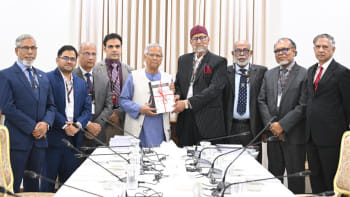Let there be light

AT the beginning of the industrial revolution, a farmer was also able to make shoes, and the women spent their days making handmade pottery and spinning yarn or cloth. In a way industry developed from small farming families which eventually turned into big companies and introduced the use of machinery for production. The primary motive of an early capitalist was to have more goods produced at a lower cost. Five hundred years have passed, in third world countries like Bangladesh many companies still want to thrive on over-exploitation of cheap labour and low production cost.
Three major industrial disasters between 2005 and 2013 claimed nearly 2000 lives and yet it failed to wake us up. The garment owners still retain the mindset of those farmers who feared that crops might fail and so they needed to maintain low production costs. This archaic attitude has resulted in consecutive industrial disasters in the last ten years. We need to change this attitude since the small-scale apparel business has turned into an industry.
Bangladesh is yet to take proper measures to ensure a better environment inside factories and improved disaster management by procuring high quality rescue equipment and ensuring training sessions for efficient rescue work.
The 23rd meeting of the Social Compliance Forum for RMG at the secretariat has revealed that faults related to workplace safety and other compliance issues were found in at least 700 export-oriented apparel units out of 2,400 factories that were inspected in Dhaka and Chittagong in 2013.
In fact, the Department of Inspection for Factories and Establishment (DIFE) is not serving its task to fight for the compliance issue. Two years after the Rana Plaza collapse, the department is yet to get the promised support of vehicles, trained workers and proper budget from the government to carry out inspections in factories. Though the National Labour Policy 2012 makes it obligatory for effective application of decent work, occupational safety and health within the general framework of rights of workers, the mushrooming of factories all around the country makes it impossible to maintain. Due to a lack of trained manpower and support, the DIFE failed to employ its first mission statement of "implementing labour laws and regulations".
National human rights commission (NHRC) in a research paper published in June last year asked the government to form the Special Approval Authority (SAA) to ensure improved factory infrastructure. Suggestions that came out of the research paper are lurking in the dust of the depository of the Labour and Employment Ministry. The amendment in 2013 of the Bangladesh Labour Act 2006 has eased many complexities but it did not add any provision for compliance. This has only served to encourage factory owners to overlook such an important matter.
Besides compliance, one of the biggest threats to our apparel industry is abduction and torture of labour leaders. Labour activist Aminul Islam is one such labour leader who was tortured to death in April 2012. Like him Golam Azam, a former elected workers representative of the Ring Shine Textile Mills was allegedly tortured by law enforcers, after he led a workers protest, demanding their due payment. Two years after the massive Rana Plaza collapse, the CID has yet to file a charge sheet. These incidents indicate a tendency of the government to ignore these crimes and punish those responsible.
We should not forget that the "Made in Bangladesh" tag brings glory and economic prosperity for our country. We do not want to lose the existing market to Vietnam, India or China. So it is now the government's responsibility to ensure a proper environment and amend the Labour Law by adding a special provision for industry compliance. The international buyers also have to stop the unethical practice of collecting apparels at the lowest possible price while ignoring possible non compliance. Instead they should have proper information about the factory before providing any orders.
Rana Plaza is a lesson for us. It should always remind us that we struggled to rescue victims from a single building. Thus it's not difficult to understand what will happen in the case of large scale disasters such as earthquakes if we do not follow proper compliance standards.
The writer is a journalist of The Daily Star.

 For all latest news, follow The Daily Star's Google News channel.
For all latest news, follow The Daily Star's Google News channel. 



Comments